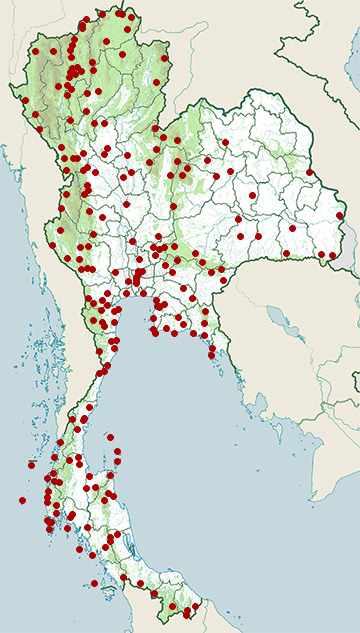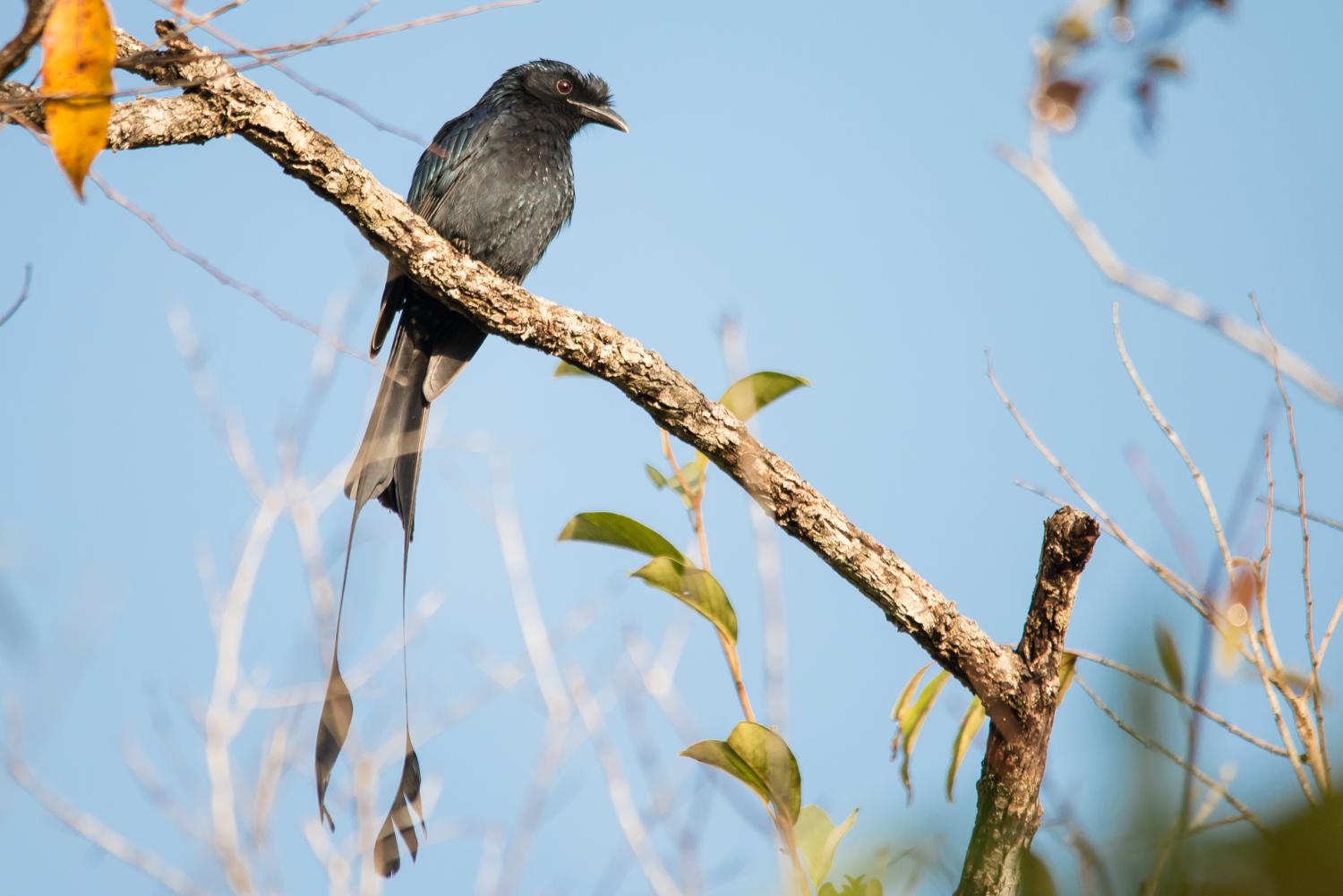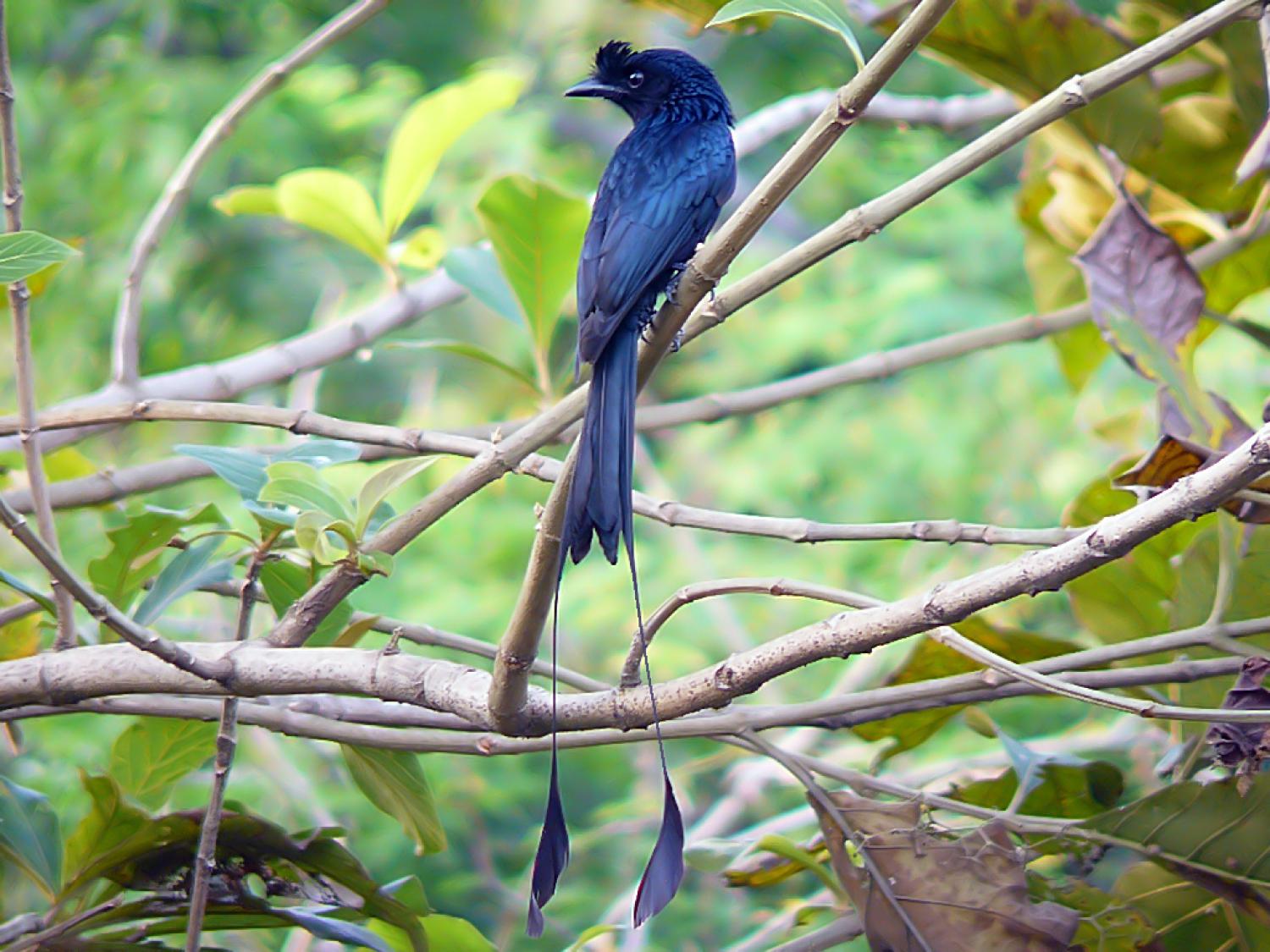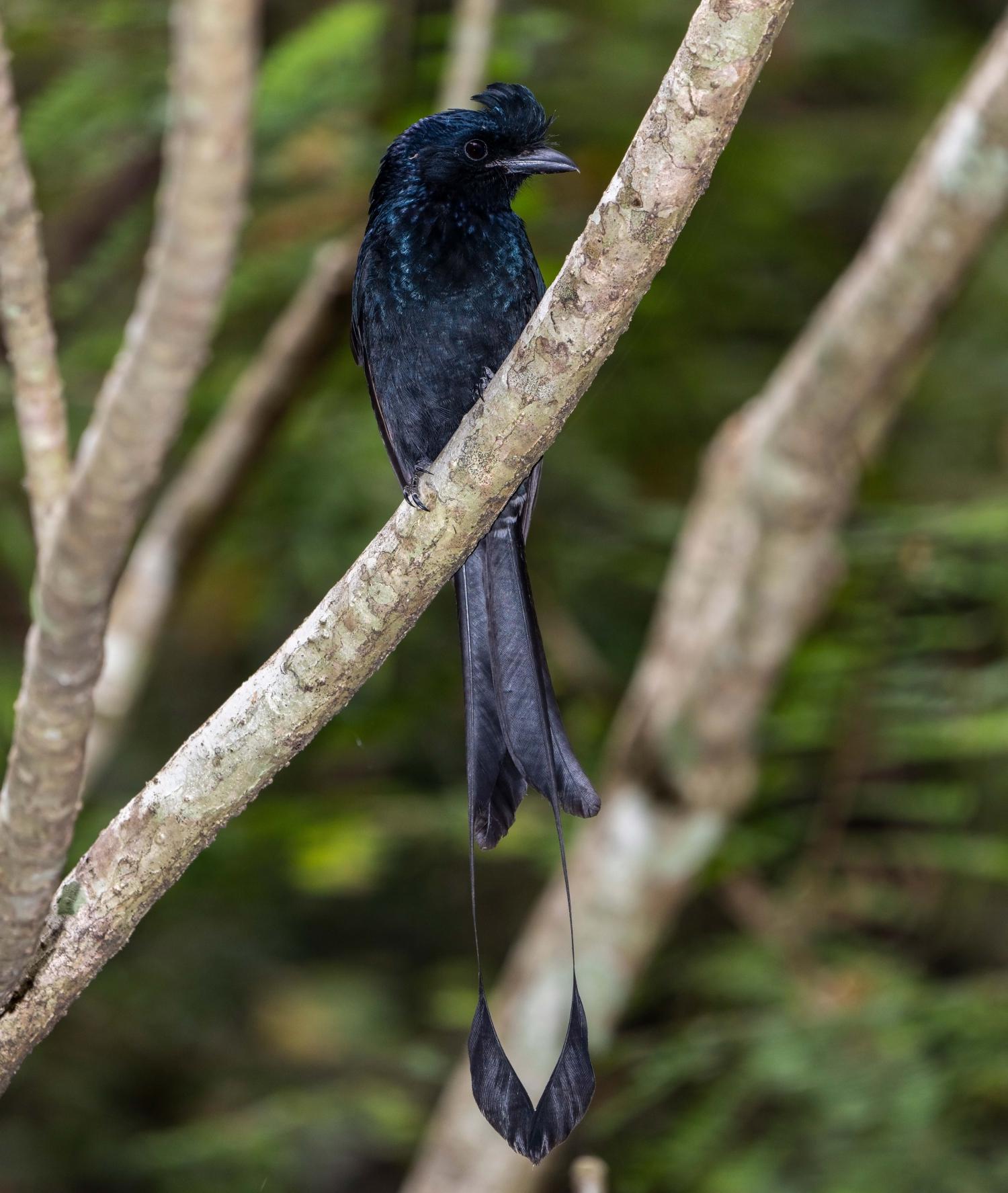Species of Thailand
Greater racquet-tailed drongo
Dicrurus paradiseus
Carolus Linnaeus, 1766
In Thai: นกแซงแซวหางบ่วงใหญ่
The Greater Racket-tailed Drongo (Dicrurus paradiseus) is a medium-sized Asian bird which is distinctive in having elongated outer tail feathers with webbing restricted to the tips. They are placed along with other drongos in the family Dicruridae. They are conspicuous in the forest habitats often perching in the open and by attracting attention with a wide range of loud calls that include perfect imitations of many other birds. It has been suggested that these imitations may help in the formation of mixed-species foraging flocks, a feature seen in forest bird communities where many insect feeders forage together. These drongos will sometimes steal insect prey caught or disturbed by other foragers in the flock. They are diurnal but are active well before dawn and late at dusk. Owing to their widespread distribution and distinctive regional variation, they have become iconic examples of speciation by isolation and genetic drift.
Description
In most of its range in Asia, this is the largest of the drongo species and is readily identifiable by the distinctive tail rackets and the crest of curled feather that begin in front of the face above the beak and along the crown to varying extents according to the subspecies. The tail with twirled rackets is distinctive and in flight it can appear as if two large bees were chasing a black bird. In the eastern Himalayas the species can be confused with the Lesser Racket-tailed Drongo, however the latter has flat rackets with the crest nearly absent.
This widespread species includes populations that have distinct variations and several subspecies have been named. The nominate form is found in southern India, mainly in forested areas of the Western Ghats and the adjoining hill forests of peninsular India. The subspecies in Sri Lanka is ceylonicus and is similar to the nominate form but slightly smaller. The subspecies found along the Himalayas is grandis and is the largest and has long glossy neck hackles. The Andaman Islands form otiosus has shorter neck hackles and the crest is highly reduced while the Nicobars Island form nicobariensis has a longer frontal crest and with smaller neck hackles than otiosus. The Sri Lanka Drongo D. lophorinus used to be treated as a subspecies due to the suggestion that it formed hybrids with ceylonicus is considered a separate species in newer taxonomic treatments on the basis of their overlapping ranges. Specimens of the nominate form have sometimes been confused with lophorinus. Considerable variation in shape of the bill, extent of the crest, hackles and tail rackets exists in the island populations of Southeast Asia. The Bornean brachyphorus (=insularis), banguey of Banggai lack crests (banguey has frontal feathers that arch forwards) while very reduced crests are found in microlophus (=endomychus; Natunas, Anambas and Tiomans) and platurus (Sumatra). A number of forms are known along the Southeast Asian islands and mainland including formosus (Java), hypoballus (Thailand), rangoonensis (northern Burma, central Indian populations were earlier included in this) and johni (Hainan).
Young birds are duller, and can lack a crest while moulting birds can lack the elongate tail streamers. The racket is formed by the inner web of the vane but appears to be on the outer web since the rachis has a twist just above the spatula.
Distribution and habitat
The distribution range of this species extends from the western Himalayas to the eastern Himalayas and Mishmi Hills in the foothills below 4000 feet. Continuing into the west to the islands of Borneo and Java in the east through the mainland and islands. They are found mainly in forest habitats.
Behaviour and ecology
Like other drongos, these feed mainly on insects but also feed on fruits and visit flowering trees for nectar. Having short legs, they sit upright and are often perched on high and exposed branches. They are aggressive and will sometimes mob larger birds especially when nesting. They are often active at dusk.
Their calls are extremely varied and include monotonously repeated whistles, metallic and nasal sounds as well as more complex notes and imitations of other birds. They begin calling from as early as 4 am in moonlight often with a metallic tunk-tunk-tunk series. They have an ability to accurately mimic alarm calls of other birds that are learnt through interactions in mixed-species flocks. This is quite unusual, as avian vocal mimicry has hitherto been believed to be ignorant of the original context of the imitated vocalization. African Grey Parrots are known to use imitated human speech in correct context, but do not show this behavior in nature. This drongo's context-sensitive use of other species' alarm calls is thus analogous to a human learning useful short phrases and exclamations in a number of foreign languages. A special alarm note is raised in the presence of Shikras that has been transcribed as a loud kwei-kwei-kwei...shee-cuckoo-sheecuckoo-sheecuckoo-why!. They have been said to imitate raptor calls so as to alarm other birds and steal prey from them in the ensuing panic. They are also known to imitate the calls of species (known sometimes even to fluff up and moving head and body like a Jungle Babbler) that typically are members of mixed-species flocks such as babblers and it has been suggested that this has a role in the formation of mixed-species flocks. In some places they have been found to be kleptoparasitic on others in mixed-species flock, particularly Laughingthrushes but they are most often involved in mutualistic and commensal relations. Several observers have found this drongo associating with foraging woodpeckers and there is a report of one following a troop of macaques.
The Greater Racket-tailed Drongo is a resident breeder throughout its range. The breeding season in India is April to August. Their courtship display may involve hops and turns on branches with play behaviour involving dropping an object and picking it in mid air. Their cup nest is built in the fork of a tree and the usual clutch is three to four eggs. The eggs are creamy white with blotches of reddish brown which are more dense on the broad end.
In culture
They common whistle note that is made leads to its local name in many parts of India of kothwal (which means a "policeman" or "guard", who used a whistle that produced a similar note), a name also applied to the Black Drongo and in other places as the Bhimraj or Bhringaraj. Prior to the 1950s it was often kept in captivity by people in parts of India. It was said to be very hardy and like a crow, accommodating a varied diet. Edward H. Schafer considered the Greater Racket-tailed Drongo as the basis for the divine kalaviṅka birds mentioned in Chinese and Japanese Buddhist texts.
This article uses material from Wikipedia released under the Creative Commons Attribution-Share-Alike Licence 3.0. Eventual photos shown in this page may or may not be from Wikipedia, please see the license details for photos in photo by-lines.
Category / Seasonal Status
BCST Category: Recorded in an apparently wild state within the last 50 years
BCST Seasonal status: Resident or presumed resident
Scientific classification
- Kingdom
- Animalia
- Phylum
- Chordata
- Class
- Aves
- Order
- Passeriformes
- Family
- Dicruridae
- Genus
- Dicrurus
- Species
- Dicrurus paradiseus
Common names
- Thai: นกแซงแซวหางบ่วงใหญ่
Synonyms
- Edolius grandis
- Dissemuroides paradiseus
- Dissemurus paradiseus,
Conservation status

Least Concern (IUCN3.1)
Photos
Please help us review the bird photos if wrong ones are used. We can be reached via our contact us page.
Range Map

- Ao Phang-Nga National Park
- Ban Bueng District, Chonburi
- Ban Hong Non-Hunting Area
- Bang Lamung District, Chonburi
- Bang Lang National Park
- Bang Phra Non-Hunting Area
- Bangkok Province
- Bueng Boraped Non-Hunting Area
- Chae Son National Park
- Chaiya District, Surat Thani
- Chaloem Phra Kiat District, Saraburi
- Chaloem Rattanakosin National Park
- Chiang Dao District, Chiang Mai
- Chiang Dao Wildlife Sanctuary
- Chiang Khong District, Chiang Rai
- Chiang Saen District, Chiang Rai
- Dan Sai District, Loei
- Doi Chong National Park
- Doi Inthanon National Park
- Doi Lang
- Doi Lo District, Chiang Mai
- Doi Pha Hom Pok National Park
- Doi Saket District, Chiang Mai
- Doi Suthep - Pui National Park
- Dong Kheng Forest Park
- Erawan National Park
- Fang District, Chiang Mai
- Hala-Bala Wildlife Sanctuary
- Hang Chat District, Lampang
- Hat Wanakon National Park
- Huai Chorakhe Mak Reservoir Non-Hunting Area
- Huai Kha Khaeng Wildlife Sanctuary
- Huai Sala Wildlife Sanctuary
- Huai Yang Waterfall National Park
- Kaeng Khoi District, Saraburi
- Kaeng Krachan District, Phetchaburi
- Kaeng Krachan National Park
- Kaeng Krung National Park
- Kaeng Som Maew Queen Sirikit Forest Park
- Kamphaeng Saen District, Nakhon Pathom
- Khanom District, Nakhon Si Thammarat
- Khao Ang Rue Nai Wildlife Sanctuary
- Khao Banthat Wildlife Sanctuary
- Khao Khiao - Khao Chomphu Wildlife Sanctuary
- Khao Khitchakut National Park
- Khao Laem National Park
- Khao Laem Ya - Mu Ko Samet National Park
- Khao Lak - Lam Ru National Park
- Khao Luang National Park
- Khao Nam Khang National Park
- Khao Nan National Park
- Khao Nang Phanthurat Forest Park
- Khao Phanom Bencha National Park
- Khao Phra - Bang Khram Wildlife Sanctuary
- Khao Phra Thaeo Wildlife Sanctuary
- Khao Pu - Khao Ya National Park
- Khao Sam Roi Yot National Park
- Khao Sanam Prieng Wildlife Sanctuary
- Khao Soi Dao Wildlife Sanctuary
- Khao Sok National Park
- Khao Yai National Park
- Khao Yoi District, Phetchaburi
- Khlong Lan National Park
- Khlong Luang District, Pathum Thani
- Khlong Wang Chao National Park
- Khok Sung District, Sa Kaeo
- Khon San District, Chaiyaphum
- Khuan Khanun District, Phatthalung
- Khun Chae National Park
- Khun Nan National Park
- Khun Phawo National Park
- Khun Tan District, Chiang Rai
- Khung Kraben Non-Hunting Area
- Khura Buri District, Phang Nga
- Klaeng District, Rayong
- Ko Chang National Park
- Ko Lanta National Park
- Ko Libong
- Ko Phra Thong
- Ko Samui District, Surat Thani
- Ko Tao
- Kromluang Chumphon Wildlife Sanctuary
- Kui Buri National Park
- Laem Ngop District, Trat
- Laem Son National Park
- Lan Sang National Park
- Mae Charim National Park
- Mae Fa Luang District, Chiang Rai
- Mae Moei National Park
- Mae Ngao National Park
- Mae Ping National Park
- Mae Rim District, Chiang Mai
- Mae Sot District, Tak
- Mae Taeng District, Chiang Mai
- Mae Wong National Park
- Muak Lek District, Saraburi
- Mueang Chiang Mai District, Chiang Mai
- Mueang Chonburi District, Chonburi
- Mueang Chumphon District, Chumphon
- Mueang Kamphaeng Phet District, Kamphaeng Phet
- Mueang Kanchanaburi District, Kanchanaburi
- Mueang Khon Kaen District, Khon Kaen
- Mueang Krabi District, Krabi
- Mueang Lampang District, Lampang
- Mueang Nakhon Nayok District, Nakhon Nayok
- Mueang Nonthaburi District, Nonthaburi
- Mueang Pathum Thani District, Pathum Thani
- Mueang Phang Nga District, Phang Nga
- Mueang Phetchaburi District, Phetchaburi
- Mueang Phichit District, Phichit
- Mueang Phitsanulok District, Phitsanulok
- Mueang Phuket District, Phuket
- Mueang Prachinburi District, Prachinburi
- Mueang Prachuap Khiri Khan District, Prachuap Khiri Khan
- Mueang Ranong District, Ranong
- Mueang Ratchaburi District, Ratchaburi
- Mueang Rayong District, Rayong
- Mueang Samut Sakhon District, Samut Sakhon
- Mueang Sisaket District, Sisaket
- Mueang Sukhothai District, Sukhothai
- Mueang Surat Thani District, Surat Thani
- Mueang Surin District, Surin
- Mueang Tak District, Tak
- Nam Nao National Park
- Nam Phong National Park
- Nam Yuen District, Ubon Ratchathani
- Namtok Mae Surin National Park
- Namtok Pha Charoen National Park
- Namtok Phlio National Park
- Namtok Sam Lan National Park
- Nong Bong Khai Non-Hunting Area
- Nong Thung Thong Non-Hunting Area
- Nong Ya Plong District, Phetchaburi
- Nong Yai Area Development Project Under Royal Init
- Op Khan National Park
- Pa Sang District, Lamphun
- Pachee River Wildlife Sanctuary
- Pai District, Mae Hong Son
- Pak Chong District, Nakhon Ratchasima
- Pak Kret District, Nonthaburi
- Pak Thale
- Pak Tho District, Ratchaburi
- Pang Sida National Park
- Pang Sila Thong District, Kamphaeng Phet
- Pathio District, Chumphon
- Pha Daeng National Park
- Pha Hin Ngam National Park
- Pha Taem National Park
- Phan District, Chiang Rai
- Phatthana Nikhom District, Lopburi
- Phi Phi Islands
- Pho Prathap Chang District, Phichit
- Phra Nakhon Si Ayutthaya District, Phra Nakhon Si Ayutthaya
- Phu Chong Na Yoi National Park
- Phu Foi Lom National Park
- Phu Hin Rong Kla National Park
- Phu Khiao Wildlife Sanctuary
- Phu Luang Wildlife Sanctuary
- Phu Pha Thoep National Park
- Phu Suan Sai National Park
- Phu Toei National Park
- Phu Wiang National Park
- Phutthamonthon District, Nakhon Pathom
- Pran Buri District, Prachuap Khiri Khan
- Pran Buri Forest Park
- Ramkhamhaeng National Park
- Sai Yok District, Kanchanaburi
- Sai Yok National Park
- Sakaerat Environmental Research Station
- Salak Pra Wildlife Sanctuary
- Salawin National Park
- Samae San Island
- Samut Prakan Province
- San Kala Khiri National Park
- San Sai District, Chiang Mai
- Sanam Chai Khet District, Chachoengsao
- Sattahip District, Chonburi
- Sawi District, Chumphon
- Si Racha District, Chonburi
- Si Satchanalai District, Sukhothai
- Si Satchanalai National Park
- Si Sawat District, Kanchanaburi
- Similan Islands
- Sirinat National Park
- Sri Phang-nga National Park
- Su-ngai Kolok District, Narathiwat
- Sukhirin District, Narathiwat
- Surin Islands
- Ta Phraya National Park
- Tai Rom Yen National Park
- Taksin Maharat National Park
- Takua Pa District, Phang Nga
- Tarutao National Marine Park
- Tat Mok National Park
- Tha Chana District, Surat Thani
- Tha Chang District, Sing Buri
- Tha Sala District, Nakhon Si Thammarat
- Tha Yang District, Phetchaburi
- Thai Mueang District, Phang Nga
- Thalang District, Phuket
- Thale Ban National Park
- Tham Pratun Non-Hunting Area
- Than Sadet - Koh Pha-Ngan National Park
- Thap Lan National Park
- Thong Pha Phum National Park
- Thung Salaeng Luang National Park
- Thung Yai Naresuan Wildlife Sanctuary
- Umphang Wildlife Sanctuary
- Wang Chan District, Rayong
- Wapi Pathum District, Maha Sarakham
- Wat Phai Lom & Wat Ampu Wararam Non-Hunting Area
- Wiang Lo Wildlife Sanctuary
- Yan Ta Khao District, Trang



